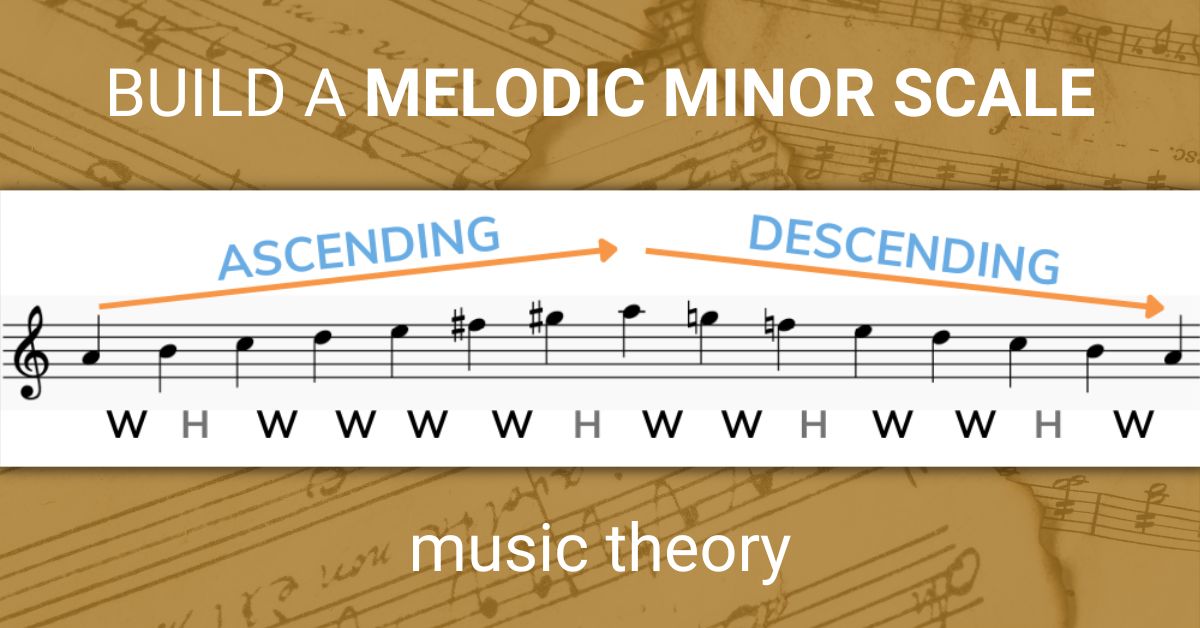How to Build a Melodic Minor Scale
November 17, 2022 by Taras (Terry) Babyuk
Introduction
The melodic minor scale is one of the three minor scales we have in music (the others being the natural minor and harmonic minor). One of the ways it is different from the other two minor scales is that it uses different notes depending on whether it is going up (ascending) or down (descending).
In this article, I am going to show you two different ways to build the melodic minor scale from any note. I hope you're excited - let's go!
Building a Melodic Minor Scale
There are two approaches we can use to building the melodic minor scale. The first is a sort of cookie-cutter method - by applying a set formula to our notes. The second is a slightly more sophisticated way that will require a bit of prior knowledge of music theory. Let's begin with the first method now.
Method #1: The Formula
This method allows us to build a melodic minor scale by simply following a formula of whole steps and half steps. Remember that the notes of this scale are different depending on whether we are going up or down, which means we will have two different formulas, one for the ascending version and the other for descending. Here they are:


Method #2: Using the Harmonic & Natural Minor Scales
For this method, we need to be familiar with the natural minor and harmonic minor scales. In my experience, this method is more practical than just memorizing a formula of whole steps and half steps as it is more meaningful for the brain, which makes it easier to remember (at least for me!). The idea here is to take the harmonic minor scale as our starting point and to modify it slightly on the way up (ascending). Then, just use the natural minor scale on the way down (descending).
If this doesn't make much sense now, don't worry! Everything will become clear when we put it to practice below, so read on!
Putting It to Practice
Example 1: "A Melodic Minor Scale"
1. Using the Formula
For our first example, let's build a relatively easy minor scale, the A Melodic Minor. Applying our formula of whole steps and half steps gives us the following result:

"A" to "B" is a whole step, "B" to "C" is a half step, "C" to "D" is a whole step, "D" to "E" is a whole step, "E" to "F♯" is a whole step, "F♯" to "G♯" is a whole step, and "G♯" to "A" is a half step. On the way down, we bring the 6th and 7th degrees down by a half step so that "G♯" becomes "G" and "F♯" becomes "F", thus giving us the A Natural Minor scale.
2. Using the Harmonic & Natural Minor Scales
For this method, we will take the A Harmonic Minor scale as our starting point, which we know contains a "G♯" as its raised 7th:
Now, we are going to modify our harmonic scale slightly by also raising the 6th degree ("F" becomes "F♯"), which is going to give us the ascending portion of our A Melodic Minor scale. So let's do that now:
Great, we're half way there. Now for the descending portion, which is even easier. All we have to do is bring our 6th and 7th degrees back down by a half step. In other words, use the A Natural Minor scale. So we get:
Putting the two together, we get a complete A Melodic Minor scale, ascending and descending:
Example 2: "D Melodic Minor Scale"
1. Using the Formula
Following our formula pattern of whole steps and half steps, our D Melodic Minor scale is:
2. Using the Harmonic & Natural Minor Scales
First, the D Harmonic Minor scale:
For the ascending part of our melodic scale, let's raise the 6th degree on the way up, so that "B♭" becomes just "B":
For the descending portion, we bring down the 6th and 7th degrees:
Putting the two together, we get a complete, ascending and descending version of the D Melodic Minor scale:
Example 3: "F♯ Melodic Minor Scale"
Lastly, let's try something a bit harder, the F♯ Melodic Minor scale.
1. Using the Formula
Following our formula patter of whole steps and half steps, we get:
2. Using the Harmonic & Natural Minor Scales
First, the F♯ Harmonic Minor scale:
For the ascending part of our melodic scale, let's raise the 6th degree on the way up, so that "D" becomes just "D♯":
For the descending portion, we bring down the 6th and 7th degrees:
Putting the two together, we get a complete, ascending and descending scale:
Conclusion
Hopefully this tutorial has made you more confident with your Melodic Minor scales.
Tip: practice writing/playing a melodic minor scale from random notes and see how long it takes you to figure it out. The more you do it, the easier it will get!
Just fill out our quick trial lesson form and wait to hear from us within 1-2 business days. If you like your trial lesson, you can sign up for regular lessons with us! Our lessons are available online (Zoom or Skype) as well as in-person if you live close to our location. Start learning your favorite instrument with one of our amazing teachers today!
